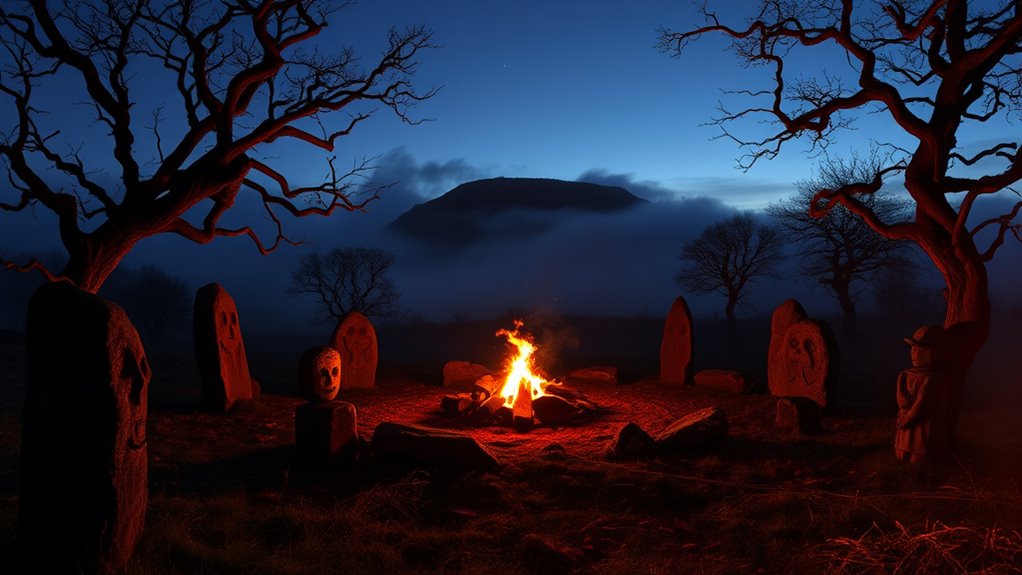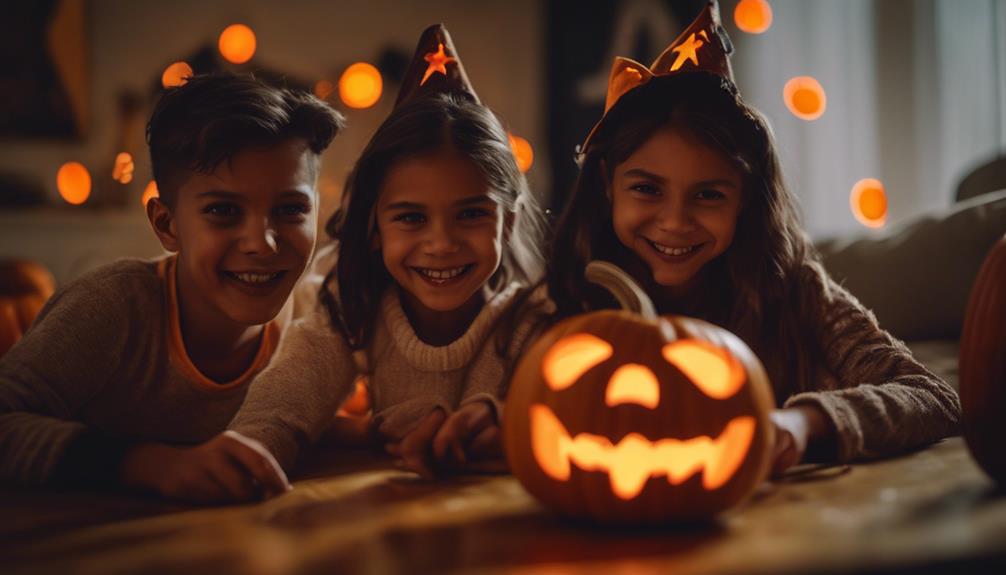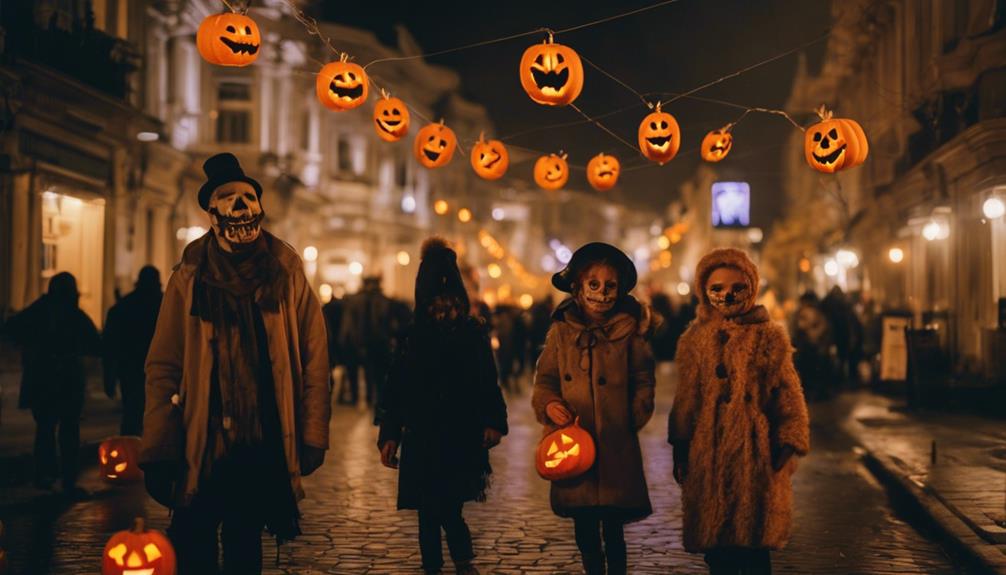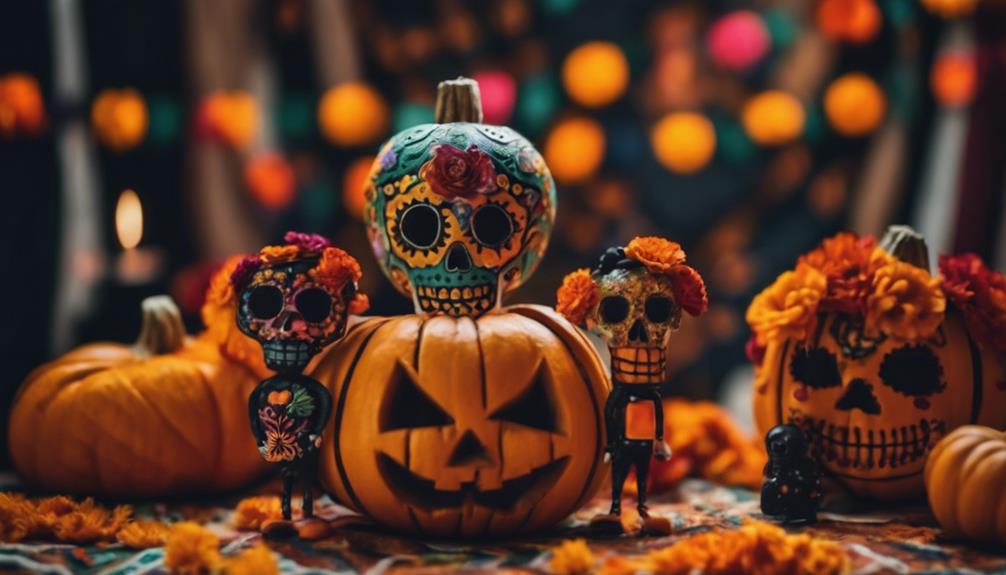Samhain is an ancient Irish Gaelic festival marking the end of the harvest season and the start of winter. You’ll find it rooted in Celtic traditions that honor ancestors and celebrate natural cycles. People light bonfires, leave offerings for spirits, and use disguises to stay safe from malevolent forces. These customs have persisted through centuries, blending community, storytelling, and music to keep cultural memories alive. Exploring more reveals how these ancient practices still influence Ireland today.
Key Takeaways
- Samhain marks the transition from harvest to winter, rooted in ancient Irish Gaelic traditions.
- It involves honoring ancestors through rituals like bonfires and offerings at graves.
- The festival emphasizes community bonding via storytelling, singing, and feasting.
- Traditions have persisted and adapted, focusing on spiritual connection and natural cycles.
- Irish music and storytelling deepen cultural understanding and commemorate ancestral heritage during Samhain.
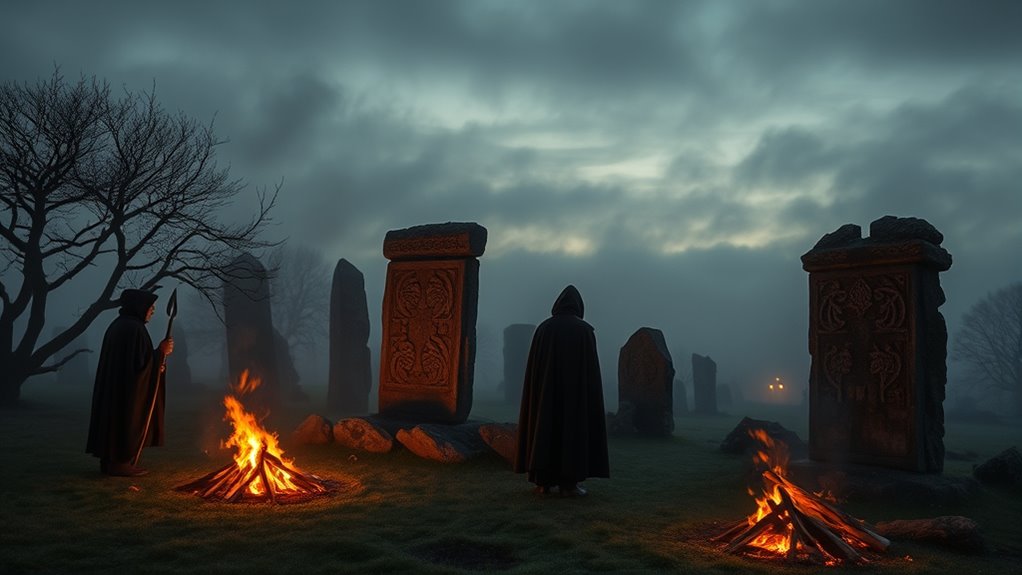
Samhain, a Gaelic festival rooted in ancient Ireland, marks the end of the harvest season and the beginning of winter. As you explore its origins, you’ll discover it’s deeply intertwined with ancestral traditions that have been passed down through generations. This festival isn’t just about celebrating the changing seasons; it’s a time when the boundaries between the living and the spirits are believed to blur. During Samhain, your ancestors’ customs come alive, offering a glimpse into the Celtic festivities that once filled Irish communities with meaning and purpose.
In ancient Ireland, people believed that on this night, the veil between worlds was at its thinnest. You’d gather around bonfires, which served as focal points for protection and communication with the spirits. These fires weren’t just for warmth—they were part of sacred rituals meant to honor ancestors and ensure their spirits continued to watch over the living. You might have left offerings at the graves of loved ones or set a place at the table for those who had passed away, continuing the ancestral traditions that kept family ties strong across generations.
Gather around bonfires to honor ancestors and communicate with spirits during Samhain’s sacred rituals.
Samhain also played a key role in Celtic festivities, emphasizing the importance of community and spiritual connection. You’d participate in storytelling, singing, and feasting, all centered around the harvest and gratitude for the year’s bounty. These customs helped reinforce social bonds, reminding everyone of their shared history and collective identity. The use of costumes or disguises during Samhain was believed to conceal you from malevolent spirits, a tradition that echoes through modern Halloween costumes. It was a way to blend into the spiritual domain, ensuring safety during a time when the supernatural was believed to be especially active.
As you learn about Samhain’s roots, you realize how its traditions have endured, adapting through centuries but still maintaining their core significance. The festival’s focus on honoring ancestors, celebrating Celtic festivities, and respecting the natural cycle of the seasons has persisted in Irish culture. Today, many observe these ancient rites by lighting candles, telling stories of loved ones no longer with us, and participating in community gatherings that echo the spirit of those early Celtic celebrations. Additionally, understanding the soundscape of traditional Irish music and storytelling helps deepen your appreciation of the cultural atmosphere that surrounded these ancient rituals. Understanding the origins of Samhain reveals how deeply Irish culture is rooted in honoring the past, celebrating the present, and preparing for the cycles of nature that continue to shape the land and its people.
Frequently Asked Questions
How Did Samhain Influence Modern Halloween Traditions?
Samhain greatly influences modern Halloween traditions by shaping Irish harvest festivals and Celtic folklore practices. You might notice how bonfires and costumes, rooted in these ancient customs, are still part of celebrations today. The holiday’s emphasis on honoring spirits and warding off evil spirits has evolved into spooky decorations and themed parties. So, when you enjoy Halloween, you’re actually participating in centuries-old traditions that stem from Samhain’s cultural origins.
What Are the Regional Variations of Samhain Celebrations in Ireland?
Imagine walking through a small Irish village, where regional customs flourish during Samhain. In some areas, you’ll find bonfires lighting the night, while others celebrate with unique local foods like boxty or colcannon. These variations reflect Ireland’s rich heritage, where traditions adapt to local landscapes and histories. Each community’s way of honoring Samhain creates a tapestry of celebrations, connecting people through shared history and diverse customs.
Are There Any Specific Myths Associated With Samhain Spirits?
During Samhain, you might hear ghost stories or feel the presence of ancestral spirits, as many believe spirits cross over to visit the living. A popular myth suggests that spirits can shape-shift or cause mischief, reminding you to respect the boundary between worlds. These stories serve to honor ancestors, warn of spirits’ antics, and remind you of the mysterious connection between the living and the dead during this magical time.
How Did Ancient Irish Communities Prepare for Samhain?
To prepare for Samhain, you would have celebrated the ancient harvest by gathering crops and offering thanks. People held ritual feasts to honor spirits and mark the season’s end. You might have built bonfires to ward off dark spirits and participated in storytelling and dances. These preparations created a sacred atmosphere, helping your community shift from the harvest season into winter, while honoring ancestors and spirits during this special time.
What Symbolic Objects Are Linked to Samhain Rituals?
Imagine pumpkin lanterns flickering in the dark, casting eerie shadows, and bone talismans hanging from doorways. These objects symbolize protection and the boundary between worlds during Samhain rituals. You might see carved pumpkins representing spirits or harvest, while bone talismans serve as powerful amulets warding off negative energies. These symbols connect you to ancient traditions, blending light and dark, life and death, to honor the spirits and guarantee a safe passage through the season.
Conclusion
Now that you know the ancient roots of Samhain, you can see why it’s such a powerful and enduring tradition. This holiday isn’t just about turning leaves and spooky costumes—it’s a gateway to the mysterious past of Ireland itself. By celebrating Samhain, you connect to a history so rich and profound, it could fill an entire universe. Embrace this ancient festival, and let its magic ignite your spirit like a thousand fireworks lighting up the night sky.
